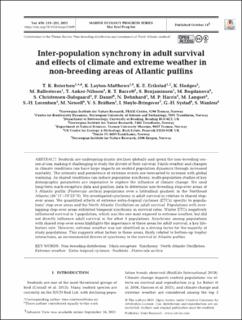| dc.contributor.author | Reiertsen, Tone Kristin | |
| dc.contributor.author | Layton-Matthews, Kate | |
| dc.contributor.author | Erikstad, K.E. | |
| dc.contributor.author | Hodges, Kevin I. | |
| dc.contributor.author | Ballesteros, Manuel | |
| dc.contributor.author | Anker-Nilssen, Tycho | |
| dc.contributor.author | Barrett, R.T. | |
| dc.contributor.author | Benjaminsen, Sigurd | |
| dc.contributor.author | Bogdanova, M. | |
| dc.contributor.author | Christensen-Dalsgaard, Signe | |
| dc.contributor.author | Daunt, Francis | |
| dc.contributor.author | Dehnhard, Nina | |
| dc.contributor.author | Harris, Michael P. | |
| dc.contributor.author | Langset, Magdalene | |
| dc.contributor.author | Lorentsen, Svein-Håkon | |
| dc.contributor.author | Newell, Mark | |
| dc.contributor.author | Bråthen, Vegard Sandøy | |
| dc.contributor.author | Støyle-Bringsvor, I. | |
| dc.contributor.author | Systad, Geir Helge Rødli | |
| dc.contributor.author | Wanless, Sarah | |
| dc.date.accessioned | 2022-02-28T14:02:15Z | |
| dc.date.available | 2022-02-28T14:02:15Z | |
| dc.date.created | 2021-09-17T10:30:04Z | |
| dc.date.issued | 2021 | |
| dc.identifier.citation | Marine Ecology Progress Series. 2021, 676 219-231. | en_US |
| dc.identifier.issn | 0171-8630 | |
| dc.identifier.uri | https://hdl.handle.net/11250/2981772 | |
| dc.description.abstract | Seabirds are undergoing drastic declines globally and spend the non-breeding season at sea, making it challenging to study the drivers of their survival. Harsh weather and changes in climate conditions can have large impacts on seabird population dynamics through increased mortality. The intensity and persistence of extreme events are forecasted to increase with global warming. As shared conditions can induce population synchrony, multi-population studies of key demographic parameters are imperative to explore the influence of climate change. We used long-term mark-recapture data and position data to determine non-breeding stop-over areas of five Atlantic puffin (Fratercula arctica) populations over a latitudinal gradient in the north-eastern Atlantic (56°11’–70°23’N). We investigated synchrony in adult survival in relation to shared stop-over areas. We quantified effects of extreme extra-tropical cyclones (ETCs) specific to populations’ stop-over areas and the North Atlantic Oscillation on adult survival. Populations with overlapping stop-over areas exhibited temporal synchrony in survival rates. Winter ETCs negatively influenced survival in one population, which was the one most exposed to extreme weather, but did not directly influence adult survival in the other four populations. Synchrony among populations with shared stop-over areas highlights the importance of these areas for adult survival, a key life-history rate. However, extreme weather was not identified as a driving factor for four of the populations. This suggests other factors in these areas, likely related to bottom-up trophic interactions, as environmental drivers of synchrony in the survival of Atlantic puffins. | en_US |
| dc.language.iso | eng | en_US |
| dc.publisher | Inter Research | en_US |
| dc.rights | Navngivelse 4.0 Internasjonal | * |
| dc.rights.uri | http://creativecommons.org/licenses/by/4.0/deed.no | * |
| dc.title | Inter-population synchrony in adult survival and effects of climate and extreme weather in non-breeding areas of Atlantic puffins | en_US |
| dc.type | Peer reviewed | en_US |
| dc.type | Journal article | en_US |
| dc.description.version | publishedVersion | en_US |
| dc.source.pagenumber | 219-231 | en_US |
| dc.source.volume | 676 | en_US |
| dc.source.journal | Marine Ecology Progress Series | en_US |
| dc.identifier.doi | 10.3354/meps13809 | |
| dc.identifier.cristin | 1935266 | |
| dc.relation.project | Norges forskningsråd: 192141 | en_US |
| dc.relation.project | Natural Environment Research Council: NE/R016429/1 | en_US |
| cristin.ispublished | true | |
| cristin.fulltext | original | |
| cristin.qualitycode | 2 | |

